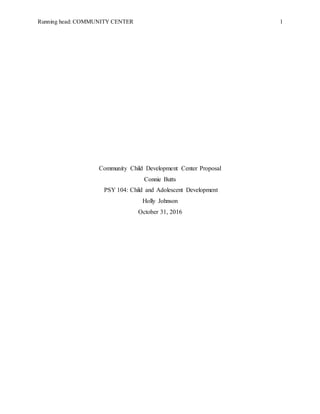The document proposes activities and equipment for five rooms in a new Community Child Development Center to support children's physical, cognitive, social, and emotional development from infancy through adolescence. The activities are supported by child development theories and research. For infants, activities like cuddling, talking, and mobiles are suggested. Toddlers would have storytime and structured playtime. Early childhood activities include finger painting and kickball. Middle childhood activities involve puzzles and group sports. Adolescents would participate in activities to promote cultural understanding and resist peer pressure. The proposal requests city council funding to furnish the center and ensure its success in helping children grow into well-adjusted adults.











![COMMUNITY CENTER 12
Reference
Archdall, K., & Kilderry, A. (2016). Supporting children's resilience: Early childhood educator
understandings. Australasian Journal of Early Childhood, 41(3), 58-65.
Bjorklund, D. F., & Brown, R. D. (1998). Physical Play and Cognitive Development: Integrating
Activity, Cognition, and Education. Child Development, (3). 604.
Carson, V., Hunter, S., Kuzik, N., Wiebe, S. A., Spence, J. C., Friedman, A., Hinkley, T.
(2016). Systematic review of physical activity and cognitive development in early
childhood. Journal of Science and Medicine in Sport, 19(7), 573-578. Doi:
http://dx.doi.org/10.1016/j.jsams.2015.07.011
http://mrsc.org/Home/Explore-Topics/Public-Safety/Special-Topics/Youth-Violence-and-
Crime-Prevention-Programs.aspx
https://www.ojjdp.gov/ojstatbb/offenders/qa03102.asp?qaDate=2014
https://www.teenhelp.com/teen-pregnancy/teen-pregnancy-statistics/
Mah, V. K., & Ford-Jones, E. L. (2012). Spotlight on middle childhood: Rejuvenating the
'forgotten years'. Paediatrics & Child Health (1205-7088), 17(2), 81-83.
McCormick, M. P., Cappella, E., Hughes, D. L., & Gallagher, E. K. (2015). Feasible, Rigorous,
and Relevant. Journal of Early Adolescence, 35(5/6), 817. Doi:
10.1177/0272431614547051
Mossler, R. (2014). Child and Adolescent Development. (2nd ed) [Electronic version]. Retrieved
from https://content.ashford.edu/](https://image.slidesharecdn.com/901699a9-5ca9-4d29-b774-c9df610d1051-170125031532/85/Final-Paper-12-320.jpg)

